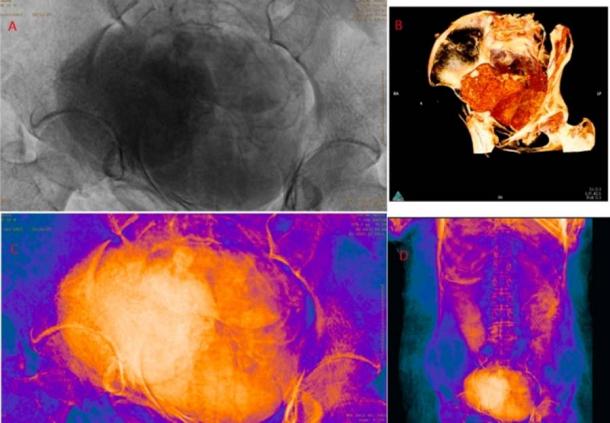When archaeologists conducted X-ray scans of a woman’s mummified body they made a remarkable discovery. The remains of the woman who died 2,000 years ago contained a surprising secret – making her mummy unlike any others found to date.
What did the scans reveal? The world’s first known pregnant mummy.
Who was the Pregnant Mummy?
A study on the discovery has been published in the Journal of Archaeological Science . In it, the researchers write that their X-ray and CT scans of the mummified body show that the woman died when she was between 20-30 years old. They measured the fetus’ head to ascertain how many weeks along the woman was in her pregnancy and found she was between 26 and 30 weeks pregnant when she died.

The pregnant mummy was identified by x-ray and CT scanning. Source: Journal of Archaeological Science
In their paper, they note that “This find is the only known case of an embalmed pregnant individual.” As study lead author Dr. Wojciech Ejsmond, of the Polish Academy of Sciences, told The Sun ,
“This is the first such discovery. There is no other so well preserved ancient body of a pregnant woman […] We know some burials of pregnant women. Mummies of babies were found in the tomb of Tutankhamun. But there is no burial of a pregnant woman with preserved soft tissue.”
However, Dr. Ejsmond also noted that “One may expect that archaeologists have come across other such burials, but they were poorly documented or badly preserved and do not offer opportunities for further research like our find.”
The researchers wonder why the fetus was mummified in the woman’s body, not extracted and embalmed on its own, as has been the case with stillborn children. “It may have been thought to be still an integral part of the body of its mother, since it was not yet born,” they wrote in their paper.

Scans revealed the woman was 26-30 weeks pregnant. ( Journal of Archaeological Science ) The researchers write that “This find is the only known case of an embalmed pregnant individual.”
The pregnant mummy is believed to have come from the Royal Tombs of the ancient city of Thebes and the researchers think that she was an elite member of society. Her mummified body was carefully wrapped in fabrics and adorned with “a rich set of amulets,” according to the researchers.
The Sun reports that the amulets represent the Four Sons of Horus and were tucked inside the wrappings. The ‘Four Sons of Horus’ refers to four gods in ancient Egyptian religion – Imsety, Duamutef, Hapi, and Qebehsenuef. They are often described as the personifications of the four canopic jars that accompanied mummified bodies.

Amulets, thought to represent the Four Sons of Horus, accompany the pregnant mummy’s body. ( Warsaw Mummy Project )
The pregnant mummy was unearthed in Thebes in the early 1800s and previous research has dated it to the first century BC – a time when Thebes was a thriving city. It arrived in Warsaw in 1826 and is currently on display in the Gallery of Ancient Art at the National Museum.
The coffin’s inscription claimed that the owner was a male priest – making the scan results even more of a surprise. Study co-author Marzena Ozarek-Szilke, an anthropologist and archeologist, said:
“Our first surprise was that it has no penis, but instead it has breasts and long hair, and then we found out that it’s a pregnant woman. When we saw the little foot and then the little hand (of the fetus), we were really shocked.”
A cause of death and the exact identity of the pregnant mummy are still a mystery.
Scanning Mummies
This mummy is only one of the mummified bodies that has been scanned through the Warsaw Mummy Project . According to the project website, the goal is to “thoroughly examine human and animal mummies from ancient Egypt at the National Museum in Warsaw.”
By using advanced technology, such as x-ray and CT scanning, the researchers say they are able to gain more insight into what life was like in ancient Egypt, as well as the age, cause of death, diseases, standard of living, and even stress levels during life of the mummies they examine.
New Insights on Pregnancy in Ancient Egypt
Dr. Ejsmond explained that the discovery of the pregnant mummy is not only amazing due to it’s unique nature, but also for Egyptologists “because we know little about perinatal health and childhood in ancient Egypt.”

‘Egyptian Fellah woman with her child,’ by Elisabeth Jerichau-Baumann, 1872. ( Public Domain )
Dr. Ejsmond also believes that the discovery opens the doors to many more points of interest:
“Physicians can study, for example, the intestinal content of the foetus to gather information on the development of the immune system in ancient times. They can also look for traces of ancient medical procedures that could have been undertaken to save the woman and her child. Ancient Egyptian medical texts detail some procedures that could have been undertaken, but more research is needed.”
Finally, this research demonstrates that other pregnant mummies may have been buried in ancient Egypt, they just haven’t been identified yet. Scanning more mummies could help researchers find them by digitally unwrapping the bodies, without physically altering the ancient mummified remains.
Top Image: X-ray and CT scans of the mummified body show that the woman died when she was between 20-30 years old. (O. Leydo )
By Alicia McDermott
Related posts:
Views: 0
 RSS Feed
RSS Feed

















 April 30th, 2021
April 30th, 2021  Awake Goy
Awake Goy 


 Posted in
Posted in  Tags:
Tags: 
















